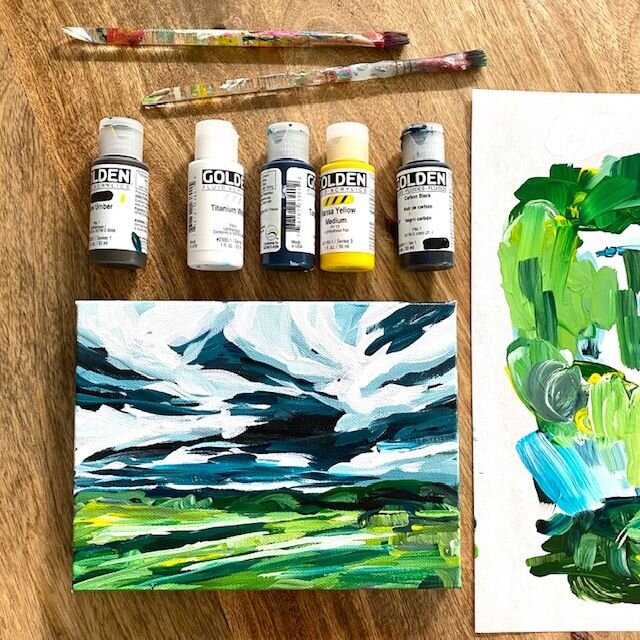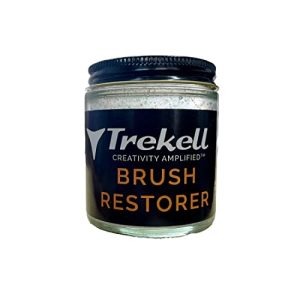Acrylic paint on canvas is versatile and easy to use. It dries quickly and offers vibrant colors.
Acrylic paints are a favorite among artists due to their flexibility and vibrant hues. They adhere well to canvas, making them suitable for both beginners and professionals. The quick drying time allows for easy layering and corrections. This medium is water-based, ensuring easy cleanup with just soap and water.
Artists can achieve various textures and finishes by using different techniques and tools. Acrylics are also known for their durability, ensuring that artwork remains vibrant over time. Whether aiming for a realistic portrait or an abstract piece, acrylic paint on canvas provides endless creative possibilities.

Credit: ellebyers.com
The Allure Of Acrylics On Canvas
Acrylic paint on canvas captivates artists and art lovers alike. Its unique qualities make it a favorite for many. This medium offers vibrant colors and unmatched versatility. Let’s explore why acrylic paint on canvas is so alluring.
Versatility And Vibrancy
Acrylic paint provides artists with incredible versatility. It can mimic watercolor or oil paints. You can create a wide range of effects with it. The colors are bold and vibrant, making artwork stand out. Blending and layering are easy with acrylics. This allows for intricate detailing and texture.
Here are some key reasons why acrylics are versatile:
- Can be thinned with water for a watercolor effect.
- Thick applications create texture and depth.
- Mix with mediums for different finishes.
Fast Drying Times
Acrylic paint dries quickly. This is a major benefit for artists. Fast drying times allow for rapid layering. You don’t have to wait long to add new elements. This makes acrylics perfect for quick projects and experiments.
Here are some advantages of fast drying times:
- Less waiting time between layers.
- Reduced risk of smudging.
- Faster completion of artwork.
| Feature | Benefit |
|---|---|
| Fast Drying | Quick project turnaround |
| Vibrant Colors | Eye-catching artwork |
| Versatility | Various artistic effects |
Gathering Your Supplies
Creating a beautiful canvas painting requires the right supplies. Having the right materials can make your painting experience enjoyable and successful. Let’s explore the essentials for your acrylic painting journey.
Choosing Quality Canvas
A good canvas is the foundation of your artwork. High-quality canvases are important for durability and better paint adherence. Here are some things to consider:
- Material: Choose cotton or linen canvases for the best results.
- Pre-stretched: Pre-stretched canvases save time and effort.
- Primed: Primed canvases are ready to use right away.
The right canvas ensures that your artwork lasts longer and looks better.
Essential Acrylic Paints And Brushes
Acrylic paints come in various colors and qualities. Having a basic set of colors is essential. Here are some must-have colors:
| Color | Use |
|---|---|
| Primary Colors | Red, blue, and yellow for mixing other colors. |
| White | For lightening colors and highlights. |
| Black | For darkening colors and shadows. |
Investing in good quality brushes is equally important. Here are some essential brushes:
- Flat Brush: For broad strokes and filling areas.
- Round Brush: For detailed work and lines.
- Fan Brush: For blending and creating textures.
Having these basic supplies will set you up for a successful painting experience.
Canvas Preparation
Preparing your canvas is essential for a successful acrylic painting. Proper preparation ensures the paint adheres well and lasts longer. Here, we’ll cover the basics of priming and stretching your canvas.
Priming Basics
Priming your canvas is a crucial step. It creates a smooth surface for painting. You’ll need gesso, a primer used for canvas preparation. Follow these steps:
- Lay your canvas flat on a table.
- Pour a small amount of gesso into a container.
- Use a wide brush to apply the gesso evenly.
- Let it dry completely, usually around 24 hours.
- Apply a second coat if needed, for a smoother surface.
Priming helps the paint adhere better and prevents it from soaking into the fabric. This step ensures a more vibrant and lasting artwork.
Stretching Techniques
Stretching your canvas is vital for a taut and smooth surface. Follow these steps to stretch your canvas:
- Start with a wooden stretcher frame.
- Place the canvas over the frame, ensuring it overlaps the edges.
- Staple one side of the canvas to the frame.
- Move to the opposite side and pull the canvas tight. Staple it.
- Repeat for the other two sides, pulling the canvas tight each time.
- Check for any wrinkles and adjust as needed.
Proper stretching ensures your canvas stays taut over time. It prevents sagging and provides a stable surface for painting.

Credit: www.pinterest.com
Color Theory For Acrylic Painting
Understanding color theory is key for acrylic painting. It helps artists create vivid and harmonious artworks. Knowing how to mix colors, create depth, and achieve harmony makes your paintings stand out.
Mixing Colors
Mixing colors is an essential skill in acrylic painting. Start with primary colors: red, blue, and yellow. These colors create secondary colors: green, orange, and purple.
- Red + Blue = Purple
- Blue + Yellow = Green
- Yellow + Red = Orange
To make tertiary colors, mix a primary color with a secondary color. For example, red and orange make red-orange. Experiment with different ratios to find the perfect shade.
Creating Depth And Harmony
Depth adds a three-dimensional feel to your painting. Use light and dark shades of colors to create depth. For example, add white to blue for a lighter shade and black for a darker shade.
Harmony makes your painting pleasing to the eye. Use analogous colors, which are next to each other on the color wheel. For example, use blue, blue-green, and green together for a harmonious effect.
| Primary Color | Secondary Color | Tertiary Color |
|---|---|---|
| Red | Purple | Red-Purple |
| Blue | Green | Blue-Green |
| Yellow | Orange | Yellow-Orange |
Brushwork And Techniques
Creating art with acrylic paint on canvas involves mastering various brushwork and techniques. Each technique adds unique textures and effects to your artwork. Let’s explore two essential aspects: mastering strokes and layering and texturing.
Mastering Strokes
Brush strokes define your painting’s style and texture. To master strokes, practice controlling your brush. Use different brushes for varied effects.
- Flat Brushes: Perfect for bold strokes and filling large areas.
- Round Brushes: Great for fine details and lines.
- Fan Brushes: Ideal for blending and soft textures.
Experiment with your brush pressure. Light pressure creates thin lines, while heavy pressure results in thick strokes. Vary your brush angles for different effects.
Layering And Texturing
Layering and texturing add depth to your paintings. Acrylic paint dries quickly, allowing for easy layering.
- Base Layer: Start with a solid background color.
- Mid Layers: Add details and shapes.
- Top Layer: Apply final highlights and accents.
To create texture, use various tools:
- Palette Knives: For thick, textured strokes.
- Sponges: For soft, blended textures.
- Toothpicks: For fine lines and details.
Combining these tools with brush techniques enhances your canvas art. Practice and experiment to discover your unique style.
Exploring Styles And Subjects
Painting on canvas with acrylics opens endless possibilities. You can explore different styles and subjects. This versatility allows artists to express themselves in unique ways. Let’s dive into some fascinating styles and subjects you can experiment with.
Abstract Vs. Realism
There are two main styles: Abstract and Realism. Each offers a different approach.
| Abstract | Realism |
|---|---|
| Focuses on shapes and colors. | Represents real-world subjects. |
| Emotional and expressive. | Detailed and accurate. |
| No need for recognizable forms. | Recognizable and lifelike. |
Abstract art lets your imagination run wild. Realism requires attention to detail. Both styles are rewarding and can improve your skills.
Choosing A Focal Point
Selecting a focal point is crucial in any painting. This is the main area of interest.
- Decide what stands out the most.
- Ensure it draws viewers’ eyes first.
- Use contrasting colors to highlight it.
A strong focal point makes your painting more engaging. It keeps viewers interested and adds depth to your work.
Sealing And Protecting Your Artwork
Once you finish your acrylic painting, it’s crucial to seal and protect it. This ensures the colors remain vibrant and the canvas stays in good condition. Proper sealing can also protect the artwork from dust, dirt, and UV rays. In this section, we’ll explore various methods to varnish and care for your acrylic paintings.
Varnishing Methods
Varnishing is essential for protecting your acrylic painting. There are different varnishing methods you can use:
- Spray Varnish: Easy to apply and gives an even coat. Hold the can 12 inches from the canvas. Spray in a steady, back-and-forth motion.
- Brush-On Varnish: Offers more control and thicker coverage. Use a wide, soft brush. Apply in even strokes, ensuring no bubbles form.
| Varnish Type | Application Method | Pros | Cons |
|---|---|---|---|
| Spray Varnish | Spray can | Even coat, quick drying | Can be messy, requires ventilation |
| Brush-On Varnish | Brush | More control, thicker coverage | Time-consuming, potential brush strokes |
Long-term Care
Long-term care is vital to keep your artwork pristine. Here are some tips:
- Avoid Direct Sunlight: UV rays can fade colors.
- Dust Regularly: Use a soft, dry cloth to clean the surface.
- Store Properly: If not displaying, keep the painting in a cool, dry place.
- Check for Damage: Inspect your artwork periodically for any signs of wear.
Following these steps ensures your acrylic paintings remain beautiful for years.
Showcasing Your Finished Piece
Showcasing your finished acrylic paint on canvas is exciting. It’s your chance to share your creativity with the world. Displaying your artwork properly can enhance its appeal. Here are some tips on framing and exhibiting your masterpiece.
Framing Options
Choosing the right frame is crucial. It protects your canvas and adds to its beauty. There are several framing options to consider:
- Floating Frames: These frames give a modern look. They create a gap between the canvas and frame.
- Standard Frames: These frames cover the edges of your canvas. They are available in various styles and materials.
- Gallery Wrap: This method involves stretching the canvas over thick stretcher bars. The sides of the canvas are painted, giving it a finished look.
Select a frame that complements the colors and theme of your artwork. A good frame can make your piece stand out.
Exhibition Tips
Displaying your artwork in an exhibition can be rewarding. Here are some tips to help you prepare:
- Choose the Right Venue: Find a space that suits your artwork. Galleries, cafes, and community centers are good options.
- Prepare Your Artwork: Ensure your canvas is clean and free from dust. The frame should be in good condition.
- Label Your Work: Create labels with the title, medium, and your name. This provides viewers with important information.
- Arrange Your Pieces: Plan the layout before the exhibition. Group similar works together for a cohesive look.
- Promote Your Exhibition: Use social media and local bulletin boards to spread the word. Invite friends and family to support you.
Following these tips can help you showcase your acrylic paint on canvas effectively.

Credit: www.youtube.com
Frequently Asked Questions
Can You Use Acrylic Paint On A Canvas?
Yes, you can use acrylic paint on a canvas. It dries quickly and offers vibrant colors. Acrylics are versatile and ideal for beginners.
Is Acrylic Paint Permanent On Canvas?
Yes, acrylic paint is permanent on canvas. It dries quickly and forms a durable, water-resistant finish. Properly primed canvas ensures longevity.
Do You Need To Prep A Canvas For Acrylic Paint?
Yes, you need to prep a canvas for acrylic paint. Apply gesso to prime the surface for better adhesion and longevity.
Do I Need To Seal Acrylic Paint On Canvas?
Yes, sealing acrylic paint on canvas is recommended. It protects the artwork from dust, UV rays, and fading.
What Is Acrylic Paint?
Acrylic paint is a fast-drying paint made of pigment suspended in acrylic polymer emulsion.
Can You Use Acrylic Paint On Canvas?
Yes, acrylic paint works well on canvas, offering vibrant colors and durability.
How Do You Prepare A Canvas For Acrylic Paint?
Prime the canvas with gesso to ensure better paint adhesion and longevity.
What Brushes Are Best For Acrylic Paint?
Synthetic brushes are ideal for acrylic paint due to their durability and flexibility.
Conclusion
Acrylic paint on canvas offers vibrant colors and versatility. It’s ideal for artists of all skill levels. Experiment with techniques to discover your unique style. Remember to properly prepare your canvas for the best results. Embrace creativity and enjoy the process of making beautiful artwork with acrylics.
Happy painting!




